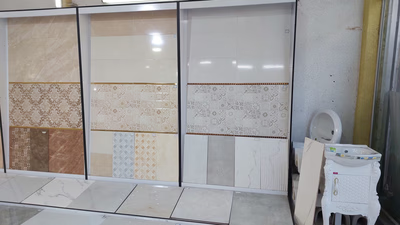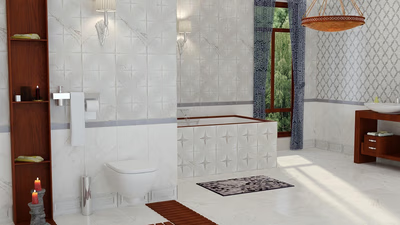
Ceramic tiles showcase rich history and craftsmanship.
One of the earliest known uses of ceramic tiles can be traced back to ancient Mesopotamia (modern-day Iraq) around 4,000 BCE. These early tiles were made from clay and were used to decorate walls and floors. Ceramic tiles were also prominent in ancient Egypt, where they were used for both practical and decorative purposes. Tiles adorned with colorful designs and hieroglyphics have been found in ancient Egyptian tombs and palaces. The Greeks and Romans further developed the art of ceramic tiles. In ancient Greece, tiles were predominantly used for mosaics and murals, featuring intricate patterns and scenes. The Romans utilized tiles extensively in their bathhouses, villas, and public buildings.
Islamic civilization played a significant role in the history of ceramic tiles. Intricate geometric patterns and Arabic calligraphy became prominent features in ceramic tile designs during the Islamic Golden Age (8th to 15th centuries). The famous blue and white tiles known as "azulejos" emerged during this period, particularly in regions such as Spain and Portugal. During the Renaissance period, ceramic tiles experienced a resurgence in Europe. Italian artisans developed new techniques, such as maiolica and majolica, which involved applying colorful glazes to tiles. These decorative tiles were used in churches, palaces, and private residences.
Some of our ancestors have lit a fire at a point where the water has well compacted the soil and found that the earth has hardened under the fire and has accidentally turned into clay. Our predecessors learned to shape clay and by putting them in the sun and drying and baking them on fire and by achieving the first hard ceramic vessels, they realized that better results can be obtained.
Shaped and baked objects are mainly pottery vessels for food. The oldest discovered works are the bowls that were baked directly on the fire. They date back to 1600 BC and were found and dated in China. Until a few years ago, those discovered in Japan were thought to be older, dating back to 120 BC. These primitive objects in their crude and unrefined forms, or primitive forms, have come down to us in an incredible way, showing their extraordinary durability.
Until the mid-1930s, the tile and ceramic industry in the Middle East was managed manually, until with the introduction of advanced industrial equipment, we saw the establishment of modern tile and ceramic factories in the Middle East. With the establishment of tile and ceramic factories in different cities of Asia, both domestic needs were met and exports flourished. Iran's tile and ceramic industry currently ranks 6th in the world and is one of the most strategic industries for Iran's economy, which has been able to significantly increase Iran's export balance. Tile and ceramic factory in Iran can play an important role in earning foreign currency for the country.
A real revolution that could be thanks to the invention of the potter's wheel, which facilitated the production of objects such as vases, plates and jugs. Compared to the primitive handicrafts, now it is possible to obtain objects that are less distorted, more symmetrical and more harmonious. The combination between the continuous rotation of the surface holding the wet clay and the hands shaping it. It helps to improve the production technique and thin the walls of objects. It is said that these are always containers for storing water and food and they are made with a practical view and not decorated.
The Industrial Revolution in the 18th and 19th centuries brought significant advancements in tile production. Mechanization and technological innovations allowed for mass production of ceramic tiles, making them more accessible to a wider population. In the 20th century, ceramic tile production continued to evolve with the introduction of new materials, glazes, and manufacturing techniques. This led to a broader range of tile designs, sizes, and finishes. Today, ceramic tiles are manufactured using modern machinery, and digital printing technology enables the creation of intricate and realistic patterns.
-

The price and quality of ceramic tiles are influenced by the materials used and the manufacturing processes. Higher-quality tiles, made from premium clay and advanced techniques, tend to be more durable and visually appealing. Thicker tiles are generally more robust, while thinner options may be more affordable but less durable. The surface finish, ranging from matte to glossy, also affects pricing; high-quality finishes ensure longevity and resistance to stains. Intricate designs and unique colors can increase costs due to specialized production methods. While aesthetic appeal is important, buyers should prioritize quality over price to avoid wasting money on inferior products. Ceramic tiles are a cost-effective flooring option for kitchens due to their durability and low maintenance costs compared to alternatives like vinyl or wood. For construction manufacturers or suppliers, purchasing directly from factories can lead to cost savings and a wider selection of products.
By eliminating middlemen, buyers can access better prices for ceramic tiles. Established brands often command higher prices due to their reputation for quality, but newer brands may offer competitive options without compromising on standards. Overall, understanding the factors that influence tile pricing can help consumers make informed decisions.
-

Ceramic tiles are made from clay and inorganic materials, fired at high temperatures, making them durable and versatile for various applications. They are commonly used in residential and commercial settings for flooring and wall coverings due to their aesthetic appeal and ease of maintenance. The manufacturing process involves shaping clay into tiles and firing them in kilns, resulting in a strong product that is resistant to water, stains, and scratches. Ceramic tiles can last many years with proper care, making them a popular choice for both functional and decorative purposes. They come in various shapes, sizes, colors, and patterns, offering extensive design options. Glazed ceramic tiles feature a protective glass layer for added durability, while unglazed tiles provide slip resistance suitable for wet areas. The historical significance of ceramic tiles dates back to 4000 BC in Egypt, highlighting their long-standing role in architecture. Their importance extends beyond aesthetics; they also contribute to environmental health by preventing moisture penetration.
-

Ceramic tiles are versatile materials widely used in both residential and commercial settings due to their durability, moisture resistance, and aesthetic appeal. They are ideal for high-traffic areas like kitchens, bathrooms, and entryways. In addition to flooring, ceramic tiles serve as wall coverings, countertops, and decorative elements in various spaces. Their chemical resistance makes them suitable for industrial applications as well. The lightweight nature of ceramic slabs reduces the structural load on buildings while allowing for diverse design options. Digital printing technologies enable the creation of unique patterns and textures, enhancing their visual appeal. Hygienic properties further contribute to their popularity over other materials like stone or cement. With a vast array of colors and designs available, ceramic tiles can be tailored to meet individual preferences in both traditional and modern architecture.
They are also used outdoors in patios and pool areas due to their weather-resistant qualities. Overall, ceramic tiles offer a combination of functionality and style that makes them a preferred choice in construction projects across the Middle East.
-

Ceramic tile production involves several key processes, starting with the selection and processing of raw materials such as clay, feldspar, and quartz. These materials are blended in precise proportions to create a homogeneous mixture. The forming process can be achieved through dry pressing or extrusion, shaping the tiles into their desired forms. After forming, tiles undergo drying to eliminate moisture, followed by glazing to enhance appearance and functionality. Glazing is applied using various methods and provides a protective finish. The critical firing process transforms the raw ceramic into a durable structure at high temperatures ranging from 1,000 to 2,500 degrees Fahrenheit. This step is essential for achieving the desired strength and color of the tiles. Post-firing, tiles are inspected for quality control, ensuring dimensional accuracy and surface integrity.
Any defective pieces are discarded before the final cutting and edge treatment processes are performed to prepare them for installation. Finally, tiles are packaged securely for transportation. The production of ceramic tiles is influenced by technological advancements that improve efficiency and quality.
-

Ceramic tiles have a rich history dating back to ancient Mesopotamia around 4,000 BCE, where they were used for decorative purposes. Ancient Egyptians also utilized tiles adorned with colorful designs in tombs and palaces. The Greeks and Romans advanced tile art, using them for mosaics and in public buildings. The Islamic Golden Age saw the emergence of intricate geometric patterns and Arabic calligraphy in tile designs, particularly the blue and white "azulejos. " The Renaissance period revived ceramic tile production in Europe with new techniques like maiolica. In the Middle East, the tile industry transitioned from manual production to modern factories by the mid-1930s, significantly boosting exports. Iran"s ceramic industry ranks sixth globally, contributing to its economy through foreign currency earnings. The Industrial Revolution further mechanized tile production, making it more accessible.
Today, advancements in technology allow for diverse designs and finishes in ceramic tiles. "
-

Ceramic tiles offer numerous advantages, making them a popular choice for flooring and wall coverings. Their durability allows them to withstand heavy foot traffic and resist scratches, ensuring longevity when properly maintained. They are water-resistant, making them ideal for moisture-prone areas like kitchens and bathrooms, while their non-porous surface prevents mold and mildew growth. Easy maintenance is another key benefit; regular cleaning requires minimal effort. The variety of sizes, shapes, colors, and patterns available allows for versatile design options that can suit any aesthetic preference. Additionally, ceramic tiles are hygienic as they do not harbor allergens or bacteria, making them suitable for individuals with allergies or respiratory issues. They are free from harmful substances such as VOCs, formaldehyde, and PVC, contributing to a healthier indoor environment. Their excellent heat resistance makes them safe around high-temperature areas without emitting toxic fumes.
Furthermore, ceramic tiles can enhance energy efficiency due to their thermal conductivity properties. Overall, the combination of durability, low maintenance needs, aesthetic versatility, and health benefits positions ceramic tiles as an excellent flooring option in various settings.






